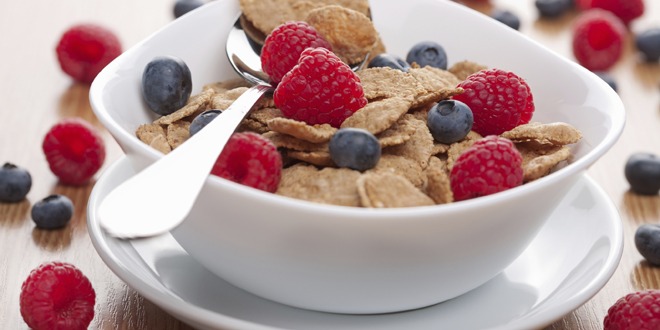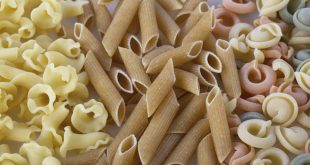When you think about beginning your day on the right track, a good place to start is with a healthy breakfast. Breakfast cereals are a popular choice because they are quick and easy to prepare. With an incredible array of options and more health claims on the package than probably any other category of food, making a healthy breakfast cereal choice can leave you wondering where to begin and what to look at first. This article will help you when you are navigating the grocery store for cereals.
The ingredient list
Begin by choosing a breakfast cereal that is whole grain and has few added ingredients, not just “made with whole grains.” Whole grains are unprocessed and include the entire grain kernel, which is where all that healthy fibre can be found. Look for the word “whole” in front of the grain within the first two ingredients. For example, “whole grain whole wheat flour” and “whole oats.” The more whole grain, the better; it’s usually splashed all over the front of the package because it’s a good thing! You may also see claims such as “100% whole grains” or a yellow stamp on the package from the Whole Grains Council. If the package says “100%,” it means all grain ingredients are whole. Products labelled with the words ”multigrain,” or ”organic“ are not necessarily whole grain – the flour or grains in the products may be made with or consist of few or no whole grains. If the list of ingredients is long and loaded with things you don’t recognize, it’s probably not the best choice.
The Nutrition Facts table
Once you’ve had a look at the ingredient list, flip the box over and read the Nutrition Facts table. (For more information about Nutrition Facts tables, click here.) The first thing to look for on a food label is the portion size, and this holds true especially when we talk about cereal.
Pay attention to portion size. A serving size of cereal can vary by type of cereal and by brand, from as little as 1/3 cup to greater than one cup per recommended serving. Most people are not aware of the portion size they eat because they don’t measure. Having a measuring cup handy will help you pour out the appropriate serving size for you. Check the serving size so that you know what amount you are comparing with another cereal. You can adjust the serving amount, as necessary, to get the amount of carbohydrate you want to have. Simply using the same-sized bowl for each type of cereal can cause your blood sugar levels to take a roller coaster ride. Heavier, denser cereal will provide more carbohydrate for the same-sized serving than one that weighs less.
Once you have checked out the serving size, scroll down the label to look at the amount of carbohydrate. Carbohydrate is the part of the cereal that will raise your blood sugar levels. The total amount of carbohydrate includes the fibre, which doesn’t get converted to glucose (sugar) in your blood. Subtracting the amount of fibre from the amount of carbohydrate will give you a better estimate of how much carbohydrate you will get. This will help you compare cereals and also calculate how much of the cereal you should eat to get the amount of carbohydrate you want to consume.
Now, let’s talk about fibre. Health Canada states that Canadian women need 25 grams of fibre per day and men need 38 grams of fibre per day; most Canadians are only getting about one-half of that. Cereals are one of the easiest ways to boost your fibre intake and help you meet this recommendation. Choose a high-fibre cereal with at least 4 grams of fibre in every serving. If you eat double the serving size, you will double the amount of fibre. However, if you choose a low-fibre cereal, you can boost the fibre amount by combining it with a high-fibre cereal or adding a small quantity of bran.
You might think that as long as you stay clear of sweetened “kids” cereals, you are pretty safe from consuming too much sugar. The”sugars” part of the label includes both natural sugar and added sugar. So, if the cereal contains dried fruit for example, the sugar from the fruit is shown here. Whenever possible, choose cereals with no added sugar; if necessary, sweeten the cereal yourself with fresh or frozen fruit. If your cereal is sweetened with added sugar, compare nutrition labels and choose the one with the least amount of added sugar.
If hot cereals are your preference, one of the healthiest cereal choices for people with diabetes is whole grain oats (oatmeal) because they are a low glycemic index option. Instant oatmeal products – the kind where you just add hot water – are highly processed and are a high glycemic index option.
Following the tips in this article should help you with the daunting task of finding a healthy cereal from among the many rows of packaged cereal in the grocery store. Whether it is something you use to start your day or as a snack later in the day, cereals are a quick, easy and tasty option.
To learn about other healthier choices while food shopping, check out Navigating the grocery store expert blogs by Dietitian and Certified Diabetes Educator, Joanne Lewis.
 Diabetes Care Community Learn, connect and care
Diabetes Care Community Learn, connect and care





One comment
Pingback: Stocking up with healthy foods - Diabetes Care Community